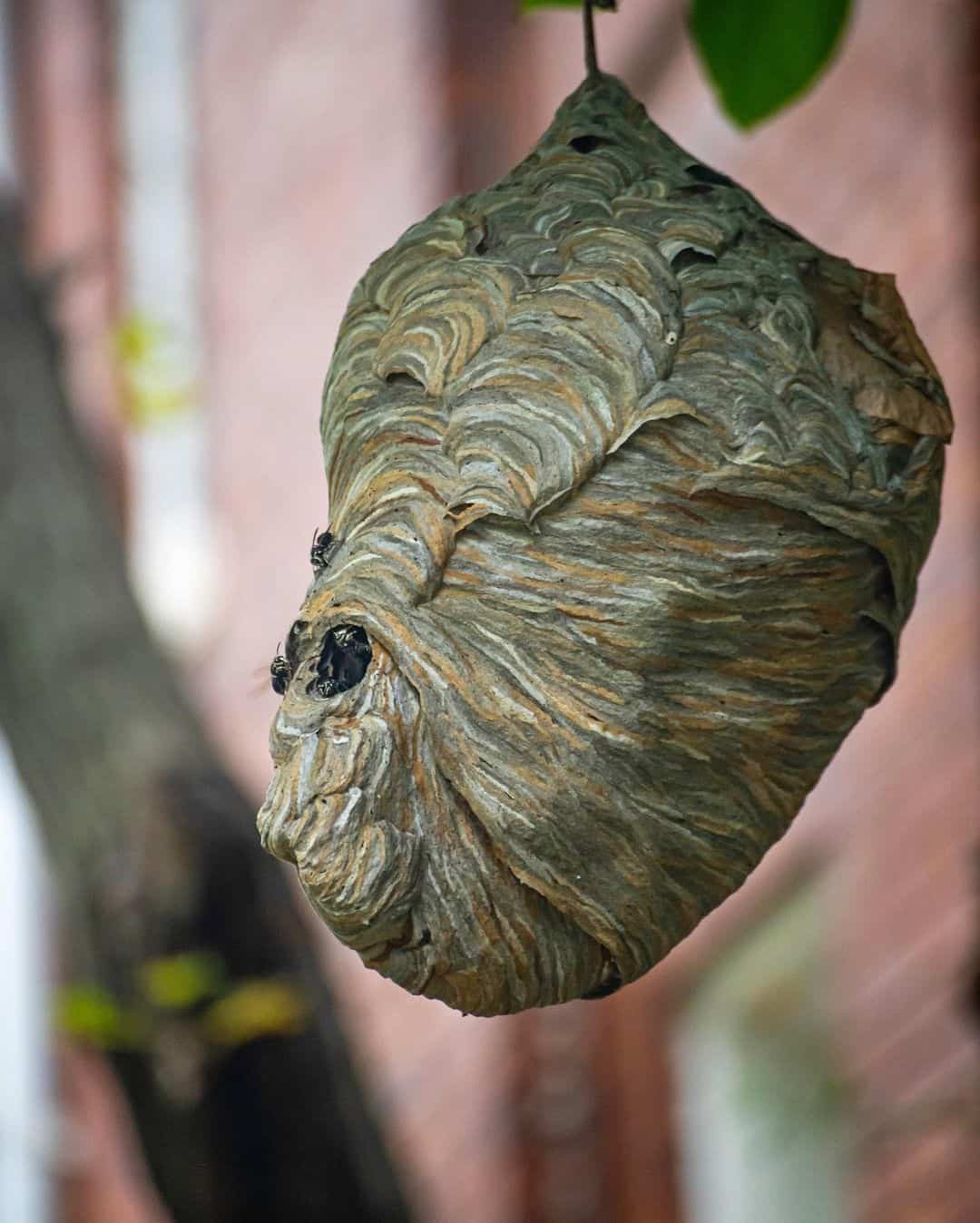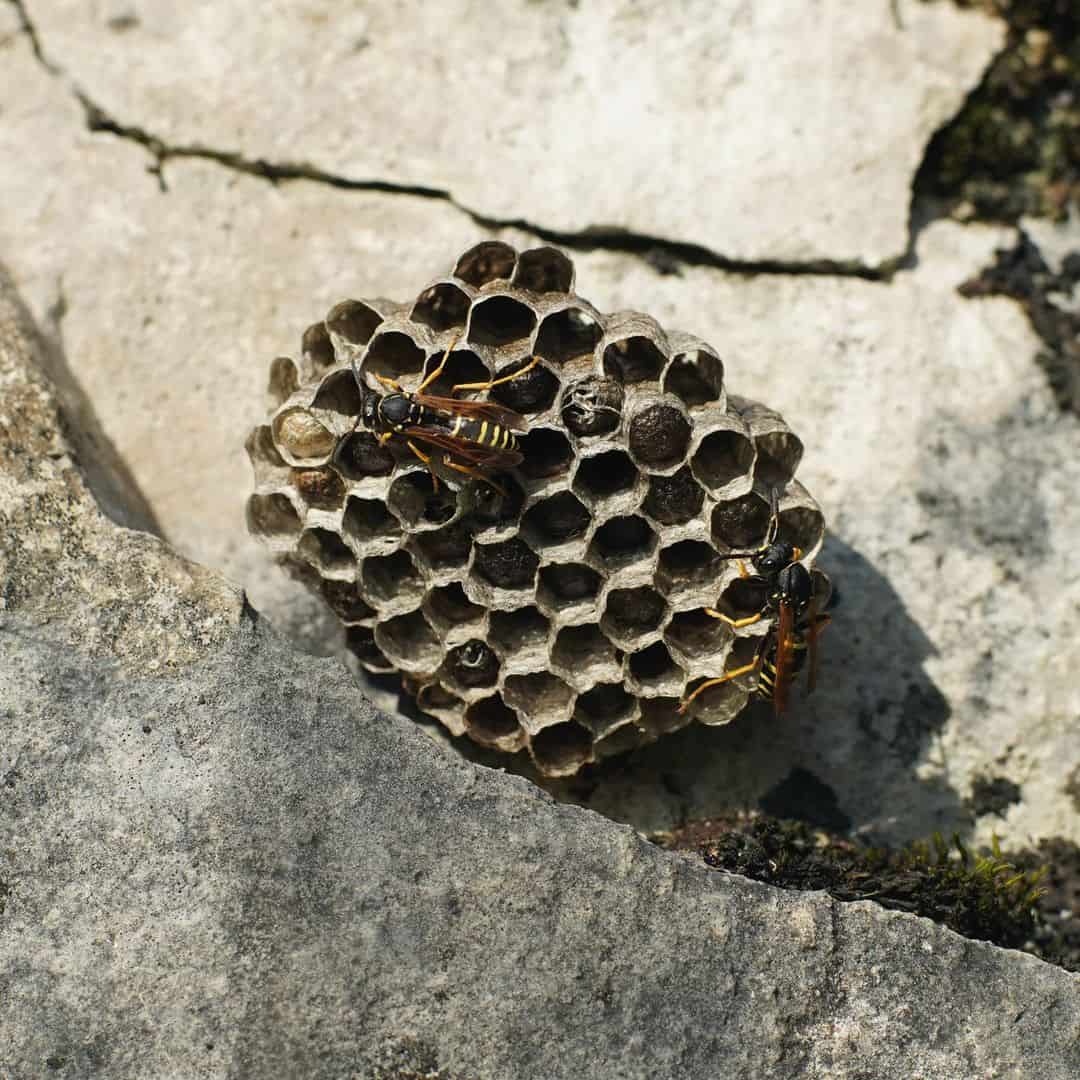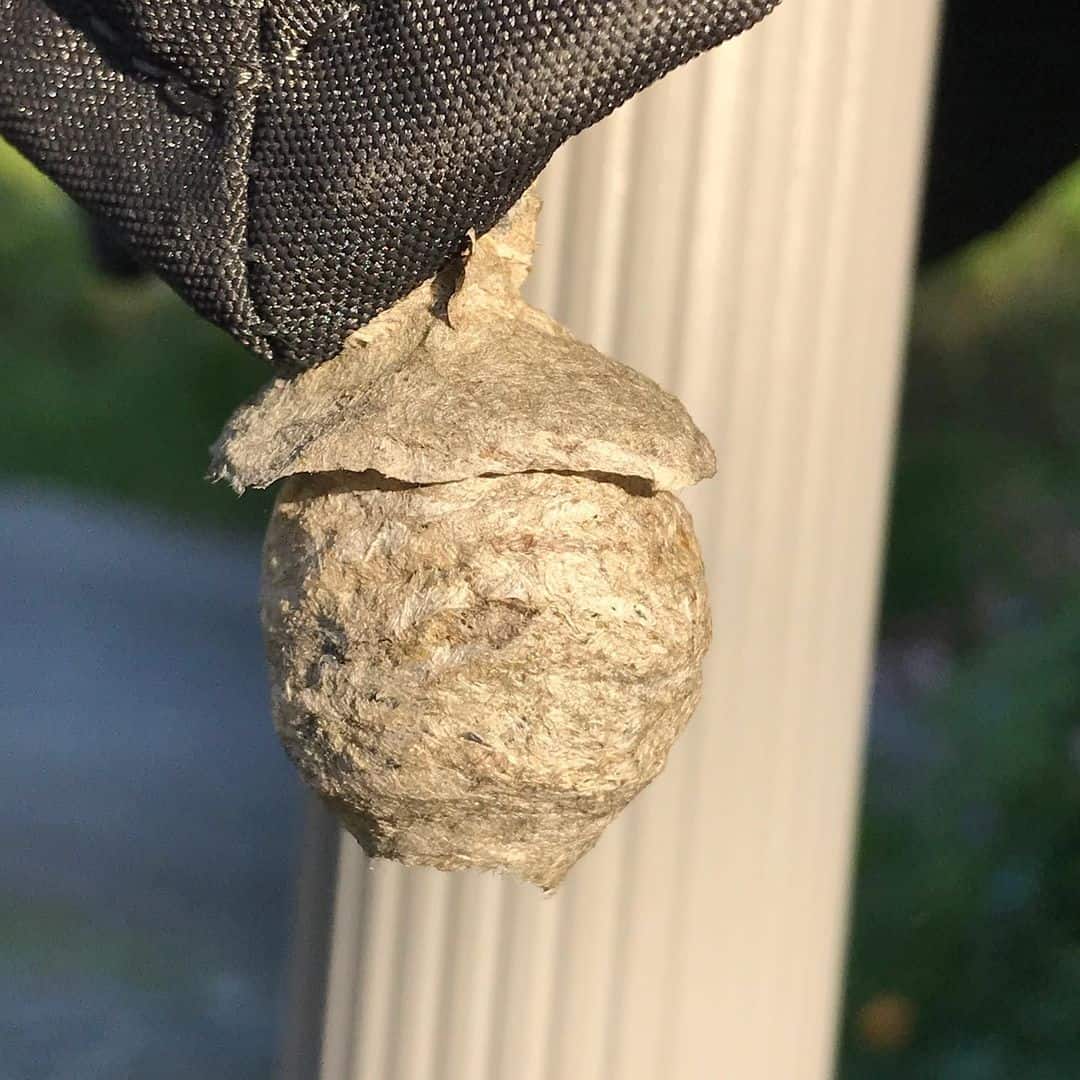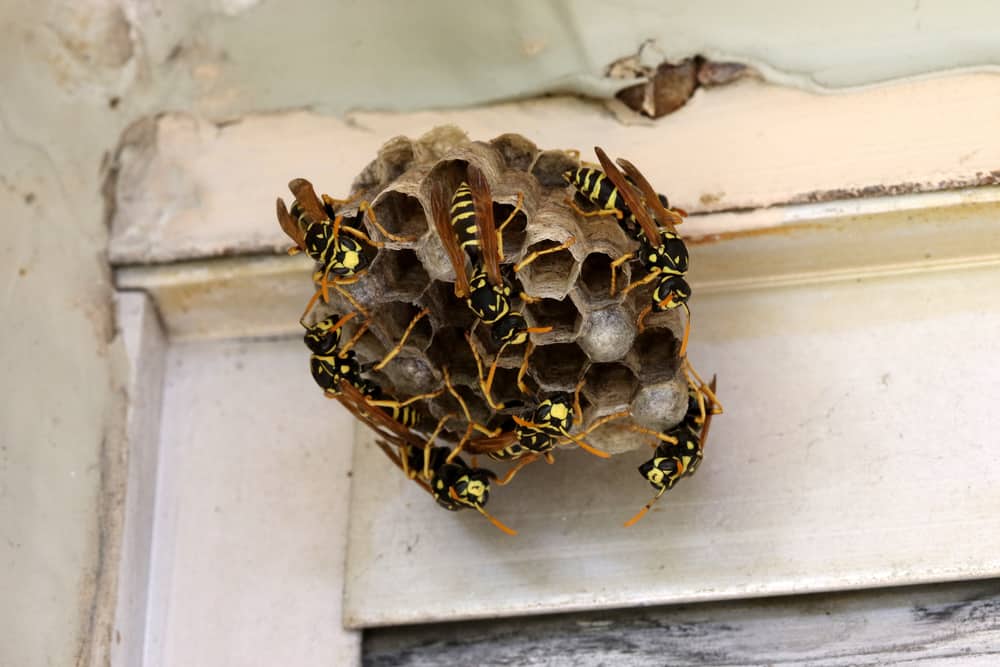Wasps are probably many people’s least favorite part of the summer. Not only can their sting be painful but it can also be dangerous if you get stung several times or are allergic. So what to do when you spot a wasp nest on your property? Is there a way to get rid of a wasp nest yourself without getting stung?
While it is not always recommended to deal with a wasp’s nest on your own, you can do it safely when taking certain precautions. If you want to remove a wasp nest yourself, continue reading to learn how to get rid of a wasp nest without getting stung.
Types of Wasps

Image Credit: neiledas
To get rid of a wasp nest safely without getting stung, you need to be prepared with the right tools and knowledge of the type of wasps you are dealing with. There are thousands of wasp species in the world but not all are nest builders. Nor are they all equally aggressive or dangerous. The types of wasps below are nest builders.
Paper Wasps
Paper wasps have yellow and black striped bodies. Their nests are exposed and shaped like upside-down umbrellas. They build their nests in places such as open ends of drainage pipes. Paper wasps are not aggressive and will attack only when they feel threatened. They have a painful sting that can be dangerous.
Yellowjackets
Yellowjackets look similar to paper wasps other than their thick black antennae. They build their nests in enclosed areas, such as cavities in the ground or wall voids. All Yellowjackets are aggressive. They will often attack in swarms and sting their target multiple times.
Hornets
Sometimes people talk about hornets and wasps as if they were completely separate species. However, hornets are a type of wasp but they are bigger and build their nests differently from saliva and chewed paper.
Where the nests are depends on the type of hornet. While many American hornets build their nests hanging from trees and bushes, European hornets build them in sheltered spots such as attics, tree hollows, and wall cavities. They are great at controlling other pests. However, they can be aggressive and dangerous with a painful sting.
How to Remove a Wasp Nest

Image Credit: heinrichandpalmer
If you want to remove a wasp nest yourself, you need to be properly prepared to avoid wasp stings and any other injury to yourself or others. Here are key things you must and mustn’t do when getting rid of a nest.
Protective Clothing
Your safety begins with protective gear. Wearing a beekeeping suit is the best option as it protects every part of your body. If you do not have a suit, you can wear a top with long sleeves and long pants such as jeans with the bottoms tucked inside socks. Wear long gloves that go over the long-sleeved shirt and cover your head with a hat and net.
The night is the Best Time to Get Rid of Wasps
It is best to remove the nest at night. Wasps are more active during the day and less aggressive during the night. When removing the nest, use an amber or red light rather than a bright flashlight which will alert the wasps.
Know Your Escape Route
Planning your escape route before you start is another key element of safe wasp nest removal. If moving the nest doesn’t go to plan, you need to know how to get away from it as quickly as possible.
No Ladders
You mustn’t use a ladder. If the wasp nest is up in a high spot such as the eaves, do not be tempted to use a ladder. If the wasps were to attack you when you disturb their nest, you could easily fall off.
Ways to Get Rid of a Wasp Nest
There are different ways to remove the wasp nest, which you will find below. If you are not sure you can deal with the wasps safely, you are allergic, or the nest is in a difficult-to-reach location, consider calling your local pest control.
Pesticide Spray
You can find a pesticide that works on wasps in most shops. To use it on the wasp infestation on your property, follow the instructions on the spray can carefully. The most common way to use the pesticide is to spray it on the nest’s opening for twenty seconds.
Repeat until there is no more activity, and then knock down the nest. This video shows you how to use the spray to get rid of a wasp nest.
Insecticidal Dust
If the wasp nest is under the ground, insecticides can work better than spray. Apply the dust on the opening of the nest liberally. Vacate the area and keep others away from it, too, for two days. Check if there is any activity around the nest and repeat applying the dust if necessary.
Smoke
You should only use this method if the nest is away from your house, for example hanging from a tree branch in the corner of your garden. Light a fire under the nest and then retire further away as the rising smoke suffocates the wasps and forces them to leave the nest. When they have all left the nest, it is safe to knock it down.
Water
Using water is the riskiest of the four options and only works on aerial nests. Begin by placing a bucket of water underneath the nest. Next, you need to get the whole nest inside a cloth bag and secure the bag tightly. Now you can knock the nest into the bucket. Cover the bucket overnight and by the morning, the wasps should all be dead.
What Can Attract Wasps to Build a Nest Near Your Home?
Many things can attract wasps and other stinging insects such as bees into your garden. Flowers, fruit-bearing trees and bushes, and bodies of still water can all attract wasps. However, it doesn’t mean they will build their nest in your garden because they often fly long distances between their nests and food and water sources.
They may choose your property for their nest if they find a secure spot that offers shelter for their colony. Unfortunately, wasps are not picky when choosing a spot for a nest. Most spots, such as overhangs and porch ceilings, where they can have protection from three sides, will suffice.
Wasp Prevention

Image Credit: troed_rhiw_haidd
Wasps are easily attracted to your garden if you grow flowers or fruit. While occasional visits are OK and even beneficial, it is best not to let them make your garden their home since wasp removal can be tricky and dangerous. So what are the ways to stop wasps from building a nest on your property?
Sealing All Entry Points
Wasps, even hornets, are small enough to get through small cracks in your home’s outside structure. Once they have found a way into a sheltered spot, they will start building a nest. To prevent this, inspect the outside of your home and seal entry points they could use for shelter.
Cover Your Garbage
Wasps will always be attracted to food waste. Leaving your food waste uncovered can bring more wasps to the vicinity of your home and could lead them to build a nest. Keep your garbage covered up especially when it contains food waste.
Collect Ripe Fruit
Have you ever spotted holes in your strawberries or apples? They could have been made by wasps attracted to ripe fruit. To avoid this, and to ensure you get to enjoy your harvest rather than the wasps, pick ripe fruit regularly, including the fruit fallen on the ground.
Make Wasp Traps
Wasp traps are easy to make. You can use a bowl or a cut-off plastic bottle. Place sugar water with some dish soap or some cooked meat as bait. Seal the top with plastic wrap and make small openings for the wasps to enter. Once in the trap, the wasps cannot figure a way out.
Use Fake Nests
Because social wasps are territorial, they will never make their nest close to an existing colony. You can fool the wasps into thinking another colony has already built a nest on your property by hanging up fake ones. Make one yourself out of brown paper or buy one from a gardening store. Some people even crochet or knit fake wasp nests.
Plant Herbs and Flowers That Repel Wasps
While many plants will attract wasps, there are others that work as wasp repellents. Herbs such as clove, basil, mint, marigolds, and geranium will naturally repel wasps. Many of them also have the added benefit of repelling fruit flies and mosquitos, too.
Conclusion
There are a few different ways you can use to get rid of a wasp nest without getting stung. You must always take necessary safety precautions to avoid danger to yourself or others. If you have any doubts about removing the nest yourself, contact a professional exterminator.
Hopefully, you now have a good understanding of how to get rid of a wasp nest without getting stung. If you have questions about removing wasp nests, you can write them in the comments section.
